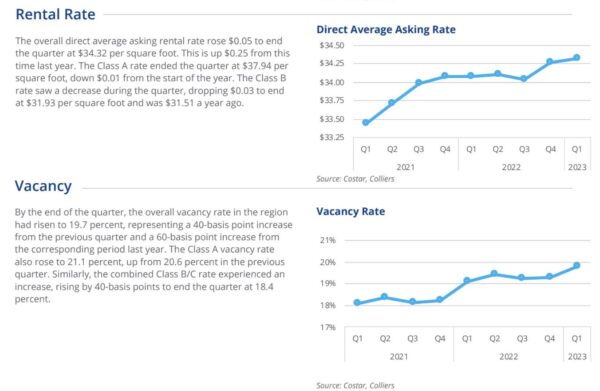
(Updated at 2 p.m.) The newest trend in office leasing may be painful for Arlington County’s office vacancy rate in the short term — but it could be beneficial in the long run.
As companies try to coax employees enjoying remote work back to the office at least part of the time, some are trading spacious leases for smaller agreements with more amenities. Landlords are responding with more investments in renovations.
“We are right-sizing from the pandemic,” said Chaise Schmidt, a senior vice president of and broker with real estate company Colliers. “It’s truly a transition period.”
Arlington County’s office vacancy rate is continuing to climb, reaching 23.7% in the first quarter of 2023. That is up from 20.8% in the summer of 2022, up from 16.6% at the beginning of 2020 and 18.7% at the beginning of 2021.
Meanwhile, a Washington Post poll published on Friday found that “two-thirds of D.C. area remote-capable workers want to work from home ‘most’ or ‘all’ of the time.” Only 3% wanted to work from home “rarely” or “never.”
Much of Arlington’s local tax base comes from commercial property with tenants in it, so a high vacancy rate can mean more pressure on residential property owners to make up the difference in their taxes — if they want the forthcoming budget to pay for the level of services currently offered.

But the news is not all bad. Organizations are still seeking to lease — they are just reducing the size of their office floor plans by 20-50% and, instead, paying more for higher-quality amenities, Colliers found. Schmidt said this has been christened the “flight-to-quality trend.”
“Business leaders are realizing you cannot build a company culture and innovation in an old, dark office space,” she said. “You need a beautiful, comfortable space, with lots of natural light, outfitted with a variety of meeting rooms of all different sizes.”
That will mean a higher vacancy in the short term but, she predicts, that rate will even out.
Some companies are moving out of older, less technologically equipped offices in lower-demand areas, dubbed “Class B and C buildings,” into more marquee “Class A and trophy class” buildings in Arlington, particularly in Rosslyn and Ballston.
“People want to be in Arlington,” Schmidt said. “Ballston and Rosslyn are getting a lot of attention.”
Two buildings in Ballston are set to come online soon: 3901 N. Fairfax Drive at the end of this year and George Mason’s FUSE at Mason Square next year.
Above-grade construction started in the fourth quarter of 2022 on 3901 Fairfax Drive, consisting of 178,131 square feet of office space, 16,185 square feet of retail and 7,311 square feet of “other space,” per a development tracking report from the Arlington County Dept. of Community Planning, Housing and Development.
The FUSE building, meanwhile, consists of 345,000 square feet for laboratories, classrooms, offices, startup incubators, co-working facilities and other uses.
“They are both true speculative buildings,” she said. “That’s showing us the confidence landlords have. They’re doubling down on Ballston.”
As for existing buildings, landlords are upgrading their leasable spaces and sweetening the deal with allowances for moving costs and for making improvements.
Common upgrades for business include establishing a tenant lounge and creating conference centers. But there are more distinctive changes.
“We’re seeing really fun amenities as well, like golf simulators,” she said. “It’s business but it’s fun, too. You want to pull people to your building.”
The Ballston Point building at 4300 Wilson Blvd was recently renovated, netting new occupants, Schmidt notes. Another building that “has done great things” in terms of amenities, 1812 N. Moore in Rosslyn — which houses the U.S. headquarters of Nestle — has been able to hold their asking rent rates, she added.
Meanwhile, she says Arlington is seeing some companies outgrow their co-working digs as more people work in-person, perhaps drawn to the office by some of the perks.
“You pay more for coworking because you get all the bells and whistles given to you, but once you get to a certain number of people coming into the office, it gets cost-prohibitive and more efficient to invest in a true office space,” she said.
Technology and defense companies are among those looking for new office space. Meanwhile, larger tenants, including government contractors, are more likely to renew for short 1-5 year periods.
“It’s difficult for large organizations to make a change,” she said. “More are waiting to see how return-to-office efforts go. A lot are saying they need more time to put a plan into action — that’s an 18-24 month journey.”
For its part, Arlington County has lately taken steps to attract emerging businesses, such as urban farms, to vacant office space. Schmidt says she has not seen things such as micro-fulfillment centers moving into Class A buildings but “it could be a different story” in Class B and C.
For Schmidt, the office trends show that it is darkest before the dawn, and Arlington should expect a combination of both good and bad news before the local office market returns to organic growth.
“I think we have to take a step back to take two steps forward,” she said.

